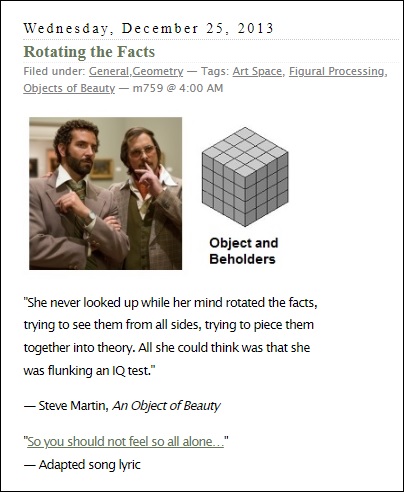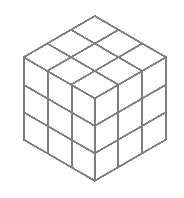Tuesday, June 20, 2023

See also . . . .

Comments Off on Emma Watson, Symmetry Surfer
Comments Off on Menu Secreto
(Continued from the previous post, Annals of Devolution)

The above seems an improved version of the
beach romp in the 2023 film of "The Portable Door."
♫ "Little bitty pretty one . . . ."
Comments Off on … And of Evolution
Monday, June 19, 2023
"… a cardboard tube, more or less the same length as
the inner core of a toilet roll, but thicker. He frowned,
took the roll out, laid it on the desk and poked up it
with the butt end of a pencil. Something slid out.
It looked like a rolled-up black plastic dustbin liner;
but when he unfolded it, he recognised it as the funny
sheet thing he’d found in the strongroom and briefly
described as an Acme Portable Door, before losing
his nerve and changing it to something less facetious."
— Holt, Tom. The Portable Door . Orbit. Kindle Edition.
According to goodreads.com, the Holt book was
"first published March 6, 2003."

Compare and contrast the "portable door" as a literary device
with the "tesseract" in A Wrinkle in Time (1962).
See also this journal on March 6, 2003.
Comments Off on The Original Portable Door
On finite geometries . . .
"Although many of these structures are studied for
their geometrical importance, they are also of great
interest in other, more applied domains of mathematics."
— Remark from the metadata of a mathematical article
dated September 22, 2021
More applied domains . . .
"Sex Show at a Brothel" — This journal on September 22, 2021.
A scene from the "Badass Song" film mentioned in that post —

Another cinematic towel scene —

Comments Off on The Date
Sunday, June 18, 2023
Comments Off on A Nemesis of Romanticism
Thursday, June 15, 2023


For the blue-black frame, a hat tip to Willard Motley.
See also the above date — 6 Nov 2021 — in this journal.
* See as well a Log24 search for Red and Gray .
Comments Off on Study in Red and Grey*
Thursday, April 27, 2023

"We're gonna find out, Pretty Mama, what turns on your lights."
See also a scene from "Hook Man."
Comments Off on “One of These Nights”
Sunday, February 26, 2023
Thursday, December 1, 2022

From Log24 last summer . . .


From Log24 yesterday:
Catchup for Blockheads . . . Da Capo
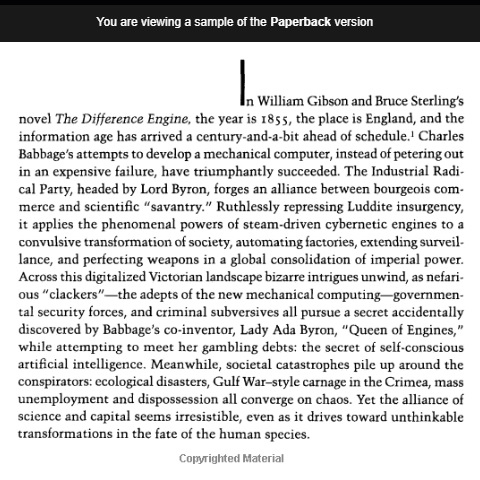
Related material: Posts tagged Metadata.
Comments Off on Compare and Contrast
Thursday, November 24, 2022
"A struggling music producer sells his soul to a 1970s drum machine."
— Summary of a short film by Kevin Ignatius, "Hook Man."

The music producer pawns his current drum device
and acquires a demonic 1970s machine.
Artistic symbolism —
The 16-pad device at left may be viewed by enthusiasts of ekphrasis
as a Galois tesseract, and the machine at right as the voice of
Hal Foster, an art theorist who graduated from Princeton in 1977.
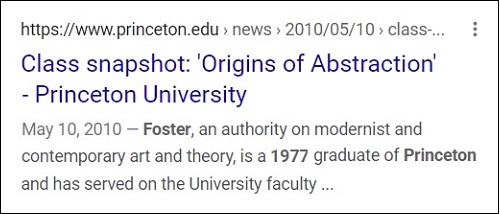
For an example of Foster's prose style, see
the current London Review of Books.
Comments Off on The Drum Machine
Monday, August 1, 2022
From Log24 posts tagged Art Space —
From a paper on Kummer varieties,
arXiv:1208.1229v3 [math.AG] 12 Jun 2013,
“The Universal Kummer Threefold,” by
Qingchun Ren, Steven V Sam, Gus Schrader,
and Bernd Sturmfels —

Two such considerations —


Comments Off on Review
Tuesday, May 10, 2022
A link to
https://www.newyorker.com/magazine/
2022/05/16/how-queer-was-ludwig-wittgenstein
appeared today in my RSS feed as . . .
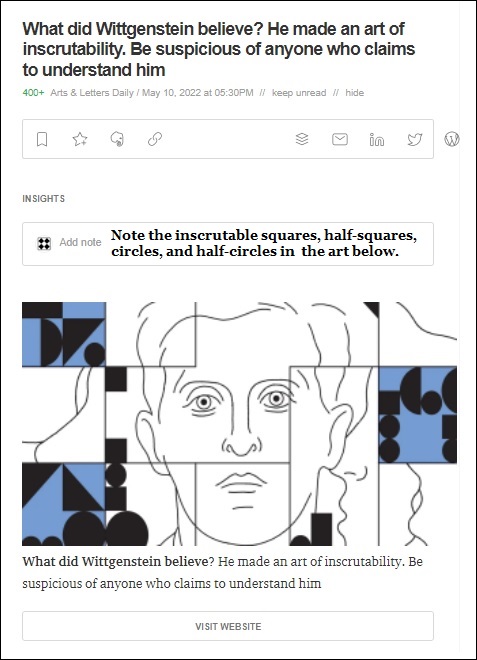
Related remarks: Art Space, a Log24 post of 7 May 2017.
The art above is by one Alexis Beauclair. See as well
an earlier illustration, also credited to Beauclair —

Comments Off on Inscrutable Art
Thursday, April 7, 2022
Comments Off on Blue Cube Group
Wednesday, April 6, 2022

The date of the above post
was also the date of . . .

Analytic Continuation —

Comments Off on Dia Space
Tuesday, April 5, 2022
"Godard, in the final analysis, expands the Warburgian programme
of iconology into that of a cinematographic iconology of the interstice."
— The author of the essay quoted in the previous post.
Comments Off on “Analysis.” — Dr. Robert Ford in “Westworld”
Monday, December 6, 2021
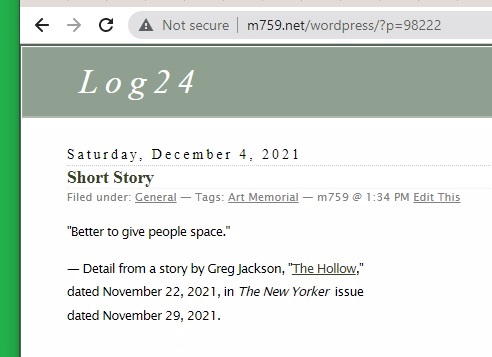
See as well posts tagged Art Space.
Comments Off on A Note for St. Nicholas
Monday, February 3, 2020

See as well a Steiner book cover in Art Space, a post of May 7, 2017.
Comments Off on Notification
Thursday, July 26, 2018
|
Interview by Alice Lloyd George [AMLG] at techcrunch.com
on April 17, 2017 —
. . . .
In an interview for Flux, I sat down with Natalya Bailey [NB], the co-founder and CEO of Accion Systems.
. . . .
AMLG: When you talk about aliens I think of one of my favorite books by Carl Sagan — Contact. I don’t know if you ever watched the movie or read the book, but I picture you like Ellie in that film. She’s this brilliant scientist and stumbles across something big.
NB: I’ve definitely seen it. I’m currently making my way through Carl Sagan’s original Cosmos again.
AMLG: I love the original Cosmos. I’m a huge Carl Sagan fan, I love his voice, he’s so inspiring to listen to. Talking about books, I know you’re an avid reader. Did any books in particular influence you or your path to building Accion?
NB: Well I’m a gigantic Harry Potter fan and a lot of things around Accion are named after various aspects of Harry Potter, including the name Accion itself.
AMLG: Is that the Accio spell? The beckoning spell?
NB: Yes exactly. My co-founder and I were g-chatting late one night on a weekend and looking through a glossary of Harry Potter spells trying to name the company. Accio, the summoning spell, if you add an “N” to the end of it, it becomes a concatenation between “accelerate” and “ion,” which is what we do. That’s the official story of how we named the company, but really it was from the glossary of spells.
|

Related material — The Orbit Stabilizer Theorem.
See also the above date — April 17, 2017 —
in posts tagged Art Space.
Comments Off on Accio Watson
Sunday, July 22, 2018
Friday, June 29, 2018

The phrase "Blue Dream" in the previous post
suggests a Web search for Traumnovelle .
That search yields an interesting weblog post
from 2014 commemorating the 1999 dies natalis
(birth into heaven) of St. Stanley Kubrick.
Related material from March 7, 2014,
in this journal —

That 2014 post was titled "Kummer Varieties." It is now tagged
"Kummerhenge." For some backstory, see other posts so tagged.
Comments Off on For St. Stanley
Sunday, March 4, 2018
1955 ("Blackboard Jungle") —

1976 —

2009 —

2016 —

Comments Off on The Square Inch Space: A Brief History
Monday, December 4, 2017

See also The Crimson Abyss (March 29, 2017).
Comments Off on Logos
Wednesday, October 25, 2017
The New York Times at 8:22 PM ET —
"Knight Landesman, a longtime publisher of Artforum magazine
and a power broker in the art world, resigned on Wednesday
afternoon, hours after a lawsuit was filed in New York accusing
him of sexually harassing at least nine women in episodes that
stretched back almost a decade."
See as well, in this journal, Way to the Egress.
Comments Off on To the Egress
From Stanford — The death on October 9, 2017, of a man who
“always wanted to be at the most cutting of cutting-edge technology.”
Related material from Log24 on April 26, 2017 —
A sketch, adapted from Girl Scouts of Palo Alto —

Click the sketch for further details.
Comments Off on The Palo Alto Edge
Monday, July 10, 2017
Publishers Weekly on a Nov. 1, 2011, book, Under Blue Cup —
"Krauss’s core argument (what she deems a 'crusade')
is that the 'white cube,' which conceptual and installation
artists have deemed obsolete, actually thrives."

For other "core arguments," see Satuday's post "Common Core"
and the Art Space posts "Odd Core" and "Even Core."
Comments Off on Under Bleu Cup
Friday, June 16, 2017
At MASS MoCA, the installation "Chalkroom" quotes a lyric —
Oh beauty in all its forms
funny how hatred can also be a beautiful thing
When it's as sharp as a knife
as hard as a diamond
Perfect
|
— From "One Beautiful Evening," by Laurie Anderson.
See also the previous post and "Smallest Perfect" in this journal.
Comments Off on Chalkroom Jungle
Thursday, June 15, 2017
Berkshire tales of May 25, 2017 —

See also, in this journal from May 25 and earlier, posts now tagged
"The Story of Six."
Comments Off on Building Six
Tuesday, June 13, 2017

This journal on the above date —


In Zoe's fall, we sinnèd all.
Comments Off on Annals of Embedded Space
Thursday, June 1, 2017
From The New York Times today —
MoMA’s Makeover Rethinks the Presentation of Art
"The new design calls for more gallery space and a transformed
main lobby, physical changes that, along with the re-examination
of art collections and diversity, represent an effort to open up MoMA
and break down the boundaries defined by its founder, Alfred Barr.
'It’s a rethinking of how we were originally conceived,' Glenn D. Lowry,
the museum’s director, said in an interview at MoMA. 'We had created
a narrative for ourselves that didn’t allow for a more expansive reading
of our own collection, to include generously artists from very different
backgrounds.'"


Comments Off on Art Spaces (For Frank Sinatra and Janet Leigh)
Tuesday, May 9, 2017
A recent book on mathematics and art
from Princeton University Press, with a
foreword by Neil deGrasse Tyson —

Not to put too fine a point on it —

From an earlier post —

Comments Off on Art Space at Princeton
Comments Off on Text and Context
Sunday, May 7, 2017
Detail of an image in the previous post —

This suggests a review of a post on a work of art by fashion photographer
Peter Lindbergh, made when he was younger and known as "Sultan."
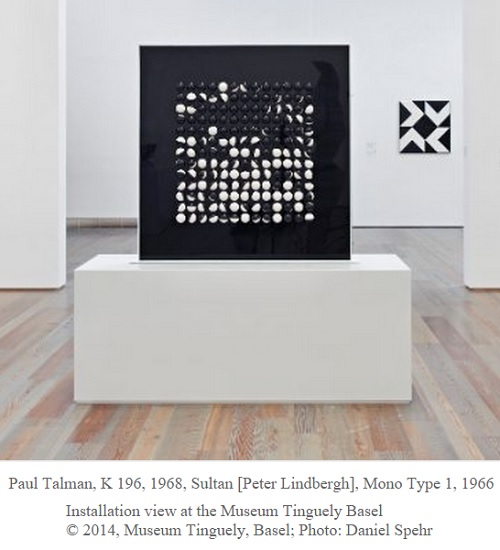
The balls in the foreground relate Sultan's work to my own.
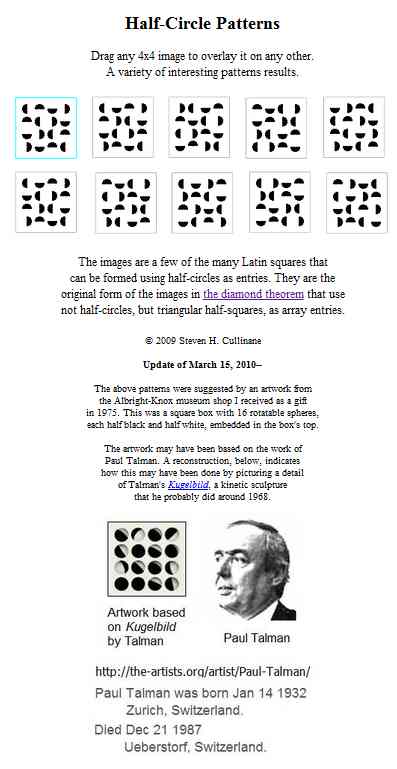
Linguistic backstory —
The art space where the pieces by Talman and by Lindbergh
were displayed is Museum Tinguely in Basel.
As the previous post notes, the etymology of "glamour" (as in
fashion photography) has been linked to "grammar" (as in
George Steiner's Grammars of Creation ). A sculpture by
Tinguely (fancifully representing Heidegger) adorns one edition
of Grammars .
Yale University Press, 2001:

Tinguely, "Martin Heidegger,
Philosopher," sculpture, 1988
Comments Off on Art Space
Tuesday, May 2, 2017
Comments Off on Image Albums
Friday, April 28, 2017
From "Seize the Dia," a post of April 6, 2013 —
"The artists demanded space
in tune with their aesthetic."
— "The Dia Generation,"
by Michael Kimmelman
“I wanted space people could be involved in.”
— An artist who reportedly died yesterday
Comments Off on Art Space
Thursday, April 27, 2017

See also a figure from 2 AM ET April 26 …

" Partner, anchor, decompose. That's not math.
That's the plot to 'Silence of the Lambs.' "
— Greg Gutfeld, September 2014

Comments Off on Partner, Anchor, Decompose
Wednesday, April 26, 2017
A sketch, adapted tonight from Girl Scouts of Palo Alto —

From the April 14 noon post High Concept —

From the April 14 3 AM post Hudson and Finite Geometry —

From the April 24 evening post The Trials of Device —


Note that Hudson’s 1905 “unfolding” of even and odd puts even on top of
the square array, but my own 2013 unfolding above puts even at its left.
Comments Off on A Tale Unfolded
Monday, April 24, 2017
"A blank underlies the trials of device"
— Wallace Stevens, "An Ordinary Evening in New Haven" (1950)
A possible meaning for the phrase "the trials of device" —

See also Log24 posts mentioning a particular device, the pentagram .
For instance —

Related figures —


Comments Off on The Trials of Device
Monday, April 17, 2017

Related art —
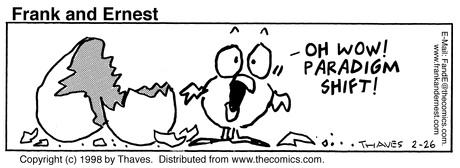
See also the previous post.
Comments Off on Hatched
Sunday, April 16, 2017

This post’s title is from the tags of the previous post —

The title’s “shift” is in the combined concepts of …
Space and Number
From Finite Jest (May 27, 2012):
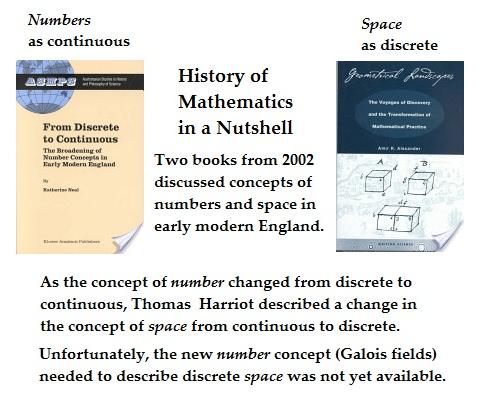
The books pictured above are From Discrete to Continuous ,
by Katherine Neal, and Geometrical Landscapes , by Amir Alexander.
For some details of the shift, see a Log24 search for Boole vs. Galois.
From a post found in that search —
“Benedict Cumberbatch Says
a Journey From Fact to Faith
Is at the Heart of Doctor Strange“
— io9 , July 29, 2016
” ‘This man comes from a binary universe
where it’s all about logic,’ the actor told us
at San Diego Comic-Con . . . .
‘And there’s a lot of humor in the collision
between Easter [ sic ] mysticism and
Western scientific, sort of logical binary.’ “
[Typo now corrected, except in a comment.]
Comments Off on Art Space Paradigm Shift
Saturday, April 15, 2017
Comments Off on Quanta Dating
Friday, April 14, 2017

The above four-element sets of black subsquares of a 4×4 square array
are 15 of the 60 Göpel tetrads , and 20 of the 80 Rosenhain tetrads , defined
by R. W. H. T. Hudson in his 1905 classic Kummer's Quartic Surface .
Hudson did not view these 35 tetrads as planes through the origin in a finite
affine 4-space (or, equivalently, as lines in the corresponding finite projective
3-space).
In order to view them in this way, one can view the tetrads as derived,
via the 15 two-element subsets of a six-element set, from the 16 elements
of the binary Galois affine space pictured above at top left.
This space is formed by taking symmetric-difference (Galois binary)
sums of the 15 two-element subsets, and identifying any resulting four-
element (or, summing three disjoint two-element subsets, six-element)
subsets with their complements. This process was described in my note
"The 2-subsets of a 6-set are the points of a PG(3,2)" of May 26, 1986.
The space was later described in the following —


Comments Off on Hudson and Finite Geometry
Thursday, April 13, 2017
See "Smallest Perfect" in this journal.
Comments Off on Space
Wednesday, April 12, 2017
The contraction of the title is from group actions on
the ninefold square (with the center subsquare fixed)
to group actions on the eightfold cube.
From a post of June 4, 2014 …
At math.stackexchange.com on March 1-12, 2013:
“Is there a geometric realization of the Quaternion group?” —

The above illustration, though neatly drawn, appeared under the
cloak of anonymity. No source was given for the illustrated group actions.
Possibly they stem from my Log24 posts or notes such as the Jan. 4, 2012,
note on quaternion actions at finitegeometry.org/sc (hence ultimately
from my note “GL(2,3) actions on a cube” of April 5, 1985).
Comments Off on Contracting the Spielraum
Cézanne's Greetings.
"Cézanne ignores the laws of classical perspective . . . ."
— Voorhies, James. “Paul Cézanne (1839–1906).”
In Heilbrunn Timeline of Art History . New York:
The Metropolitan Museum of Art, 2000–. (October 2004)
Some others do not.


This is what I called "the large Desargues configuration"
in posts of April 2013 and later.
Comments Off on Expanding the Spielraum
Tuesday, April 4, 2017
“Inside the White Cube” —
“We have now reached
a point where we see
not the art but the space first….
An image comes to mind
of a white, ideal space
that, more than any single picture,
may be the archetypal image
of 20th-century art.”

“Space: what you
damn well have to see.”
— James Joyce, Ulysses
Comments Off on White Cube
Monday, April 3, 2017
Comments Off on Even Core
Saturday, April 1, 2017
(Continued)
Click image for some backstory.

“Whatever he drew was the platonic ideal
of what a cartoon should look like.”
— Bob Mankoff on Jack Ziegler, who reportedly
died on Wednesday, March 29, 2017.
See also "Hexagram 64 in Context," March 16, 2017.
Comments Off on Art Space
Wednesday, March 29, 2017
"And as the characters in the meme twitch into the abyss
that is the sky, this meme will disappear into whatever
internet abyss swallowed MySpace."
—Staff writer Kamila Czachorowski, Harvard Crimson , March 29
1984 —

2010 —

Logo design for Stack Exchange Math by Jin Yang
Recent posts now tagged Crimson Abyss suggest
the above logo be viewed in light of a certain page 29 —
"… as if into a crimson abyss …." —

Update of 9 PM ET March 29, 2017:
Prospero's Children was first published by HarperCollins,
London, in 1999. A statement by the publisher provides
an instance of the famous "much-needed gap." —
"This is English fantasy at its finest. Prospero’s Children
steps into the gap that exists between The Lion, the Witch
and the Wardrobe and Clive Barker’s Weaveworld , and
is destined to become a modern classic."
Related imagery —


See also "Hexagram 64 in Context" (Log24, March 16, 2017).
Comments Off on The Crimson Abyss

Hexagram 29,
The Abyss (Water)
This post was suggested by an August 6, 2010, post by the designer
(in summer or fall, 2010) of the Stack Exchange math logo (see
the previous Log24 post, Art Space Illustrated) —
http://www.8164.org/☵☲/ .
In that post, the designer quotes the Wilhelm/Baynes I Ching to explain
his choice of Hexagram 63, Water Over Fire, as a personal icon —
"When water in a kettle hangs over fire, the two elements
stand in relation and thus generate energy (cf. the
production of steam). But the resulting tension demands
caution. If the water boils over, the fire is extinguished
and its energy is lost. If the heat is too great, the water
evaporates into the air. These elements here brought in
to relation and thus generating energy are by nature
hostile to each other. Only the most extreme caution
can prevent damage."
See also this journal on Walpurgisnacht (April 30), 2010 —
A thought from another German-speaking philosopher —
"Die Philosophie ist ein Kampf gegen die Verhexung
unsres Verstandes durch die Mittel unserer Sprache."
See also The Crimson 's abyss in today's 4:35 AM post Art Space, Continued.
Comments Off on Design Abyss
Another view of the previous post's art space —

More generally, see Solomon's Cube in Log24.
See also a remark from Stack Exchange in yesterday's post Backstory,
and the Stack Exchange math logo below, which recalls the above
cube arrangement from "Affine groups on small binary spaces" (1984).
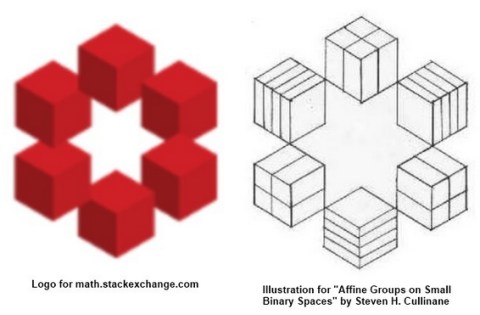
Comments Off on Art Space Illustrated
"And as the characters in the meme twitch into the abyss
that is the sky, this meme will disappear into whatever
internet abyss swallowed MySpace."
—Staff writer Kamila Czachorowski, Harvard Crimson today
From Log24 posts tagged Art Space —
From a recent paper on Kummer varieties,
arXiv:1208.1229v3 [math.AG] 12 Jun 2013,
“The Universal Kummer Threefold,” by
Qingchun Ren, Steven V Sam, Gus Schrader, and
Bernd Sturmfels —

Two such considerations —


Comments Off on Art Space, Continued
Tuesday, March 28, 2017
From Log24, "Cube Bricks 1984" —


Also on March 9, 2017 —

For those who prefer graphic art —
Broken Symmetries in Diamond Space —

Comments Off on Bit by Bit
Click here to enlarge. Click the image for the source page.

The "this page" reference is to …
Finite Geometry of the Square and Cube.
Also from March 14, 2017 —

Related material —

Comments Off on Backstory
Sunday, December 6, 2015
"Those early works are succinct and uncompromising
in how they give shape to the philosophical perplexities
of form and idea…."
J. J. Charlesworth, artnet news, Dec. 16, 2014
"Form" and "idea" are somewhat synonymous,
as opposed to "form" and "substance." A reading:


Discuss.
Comments Off on Form and Idea
Wednesday, April 22, 2015
G. H. Hardy in A Mathematician's Apology —
|
What ‘purely aesthetic’ qualities can we distinguish in such theorems as Euclid’s or Pythagoras’s?
I will not risk more than a few disjointed remarks. In both theorems (and in the theorems, of course, I include the proofs) there is a very high degree of unexpectedness, combined with inevitability and economy. The arguments take so odd and surprising a form; the weapons used seem so childishly simple when compared with the far-reaching results; but there is no escape from the conclusions. There are no complications of detail—one line of attack is enough in each case; and this is true too of the proofs of many much more difficult theorems, the full appreciation of which demands quite a high degree of technical proficiency. We do not want many ‘variations’ in the proof of a mathematical theorem: ‘enumeration of cases’, indeed, is one of the duller forms of mathematical argument. A mathematical proof should resemble a simple and clear-cut constellation, not a scattered cluster in the Milky Way.
|
Related material:
-
A post at noon on Sunday, April 19, 2015, with a link,
"Ageometretos medeis eisito," to an image search
for "large Desargues configuration" that includes …

-
A review, dated April 20, 2015, of "After Hours at the
Harvard Art Museums" in The Harvard Crimson
-
An article, also dated April 20, 2015, in Harvard Magazine
titled "Harvard Installs 'Triangle Constellation'"
Comments Off on Purely Aesthetic
Tuesday, February 3, 2015
A short poem by several authors:
"The role of
the 16 singular points
on the Kummer surface
is now played by
the 64 singular points
on the Kummer threefold."
— From Remark 2.4 on page 9 of
"The Universal Kummer Threefold,"
by Qingchun Ren, Steven V Sam,
Gus Schrader, and Bernd Sturmfels,
http://arxiv.org/abs/1208.1229v3,
August 6, 2012 — June 12, 2013.
See also "Expanded Field" in this journal.

Illustration from "Sunday School," July 20, 2014.
Other Log24 background: Kummer, Spielraum, Art Space.
Comments Off on Expanding the Spielraum
Tuesday, April 1, 2014
Comments Off on For April 1
Friday, March 7, 2014
The Dream of the Expanded Field continues…

From Klein's 1893 Lectures on Mathematics —

"The varieties introduced by Wirtinger may be called Kummer varieties…."
— E. Spanier, 1956
From this journal on March 10, 2013 —

From a recent paper on Kummer varieties,
arXiv:1208.1229v3 [math.AG] 12 Jun 2013,
"The Universal Kummer Threefold," by
Qingchun Ren, Steven V Sam, Gus Schrader, and Bernd Sturmfels —

Two such considerations —


Update of 10 PM ET March 7, 2014 —
The following slides by one of the "Kummer Threefold" authors give
some background related to the above 64-point vector space and
to the Weyl group of type E7, W (E7):

The Cayley reference is to "Algorithm for the characteristics of the
triple ϑ-functions," Journal für die Reine und Angewandte
Mathematik 87 (1879): 165-169. <http://eudml.org/doc/148412>.
To read this in the context of Cayley's other work, see pp. 441-445
of Volume 10 of his Collected Mathematical Papers .
Comments Off on Kummer Varieties
Tuesday, January 21, 2014
A NY Times researcher from this morning’s previous post
tweeted last fall about art forgery and China.

Related material — Art Cube.

Illustration from December 25, 2013.
Comments Off on Class of 64
Wednesday, December 25, 2013

"She never looked up while her mind rotated the facts,
trying to see them from all sides, trying to piece them
together into theory. All she could think was that she
was flunking an IQ test."
— Steve Martin, An Object of Beauty
"So you should not feel so all alone…"
— Adapted song lyric
Comments Off on Rotating the Facts
Saturday, April 6, 2013
On this journal:
"he seems to repeat stuff compulsively punctuated with citing others and berating them for note taken nor credit given of his precedence .. but like i said, he more than makes up for that, dredging up and dusting off his all time faves like a super expensive store keeper who moves a piece only once a decade"
— "poetpiet" on Feb. 23, 2013
This suggests moving a piece linked to here
(in an update; scroll down) a decade ago.

Photo source: http://evanfazio.com/public-relations-lessons-from-the-chess-board/
The New York Times Magazine cover story
a decade ago, on Sunday, April 6, 2003:
"The artists demanded space
in tune with their aesthetic."
— "The Dia Generation,"
by Michael Kimmelman
Related material: Occupy Space in this journal.
Sunday, May 22, 2011
A year ago today—
2:02 AM EDT—
Art Space
10:31 AM EDT—
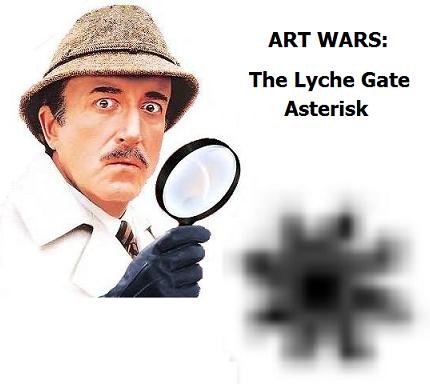
* See Vonnegut.
Comments Off on Asterisk*
Wednesday, March 16, 2011
Accidental Time and Space
New York Lottery today— midday 987, evening 522.
Time
The midday 987 may be interpreted as "…nine, eight, seven, …."—
"The countdown as we know it, 10-9-8-u.s.w.,
was invented by Fritz Lang in 1929 for
the Ufa film Die Frau im Mond . He put it into
the launch scene to heighten the suspense.
'It is another of my damned "touches,"' Fritz Lang said."
— Gravity's Rainbow
Space
The evening 522 suggests the date 5/22. From that date last year—
Art Space (2:02 AM EDT)
“Space: what you damn well have to see.”
– James Joyce, Ulysses
Comments Off on Time and Chance (continued)
Sunday, February 20, 2011
From Galleri MGM in Oslo —

Josefine Lyche
Theme and Variations
26. February – 28. March 2009
Opening reception 26. February 19.00 – 21.00
"Why do we remember the past, but not the future?"
Stephen Hawking, A Brief History of Time, Ch. 9, "The Arrow of Time"
"If you want a vision of the future, imagine a boot stamping on a human face – forever."
George Orwell
Galleri MGM is pleased to present the second solo exhibition by Josefine Lyche (b.1973).
Lyche presents a body of work consisting of sculptures and a wall painting, as well as a series of new paperwork, all using geometrical abstractions and light as a medium. Her work dissolves boundaries between fiction and documentation, depicting how fantasies and dreams collide with and yet help determine the shape of reality.
Theme and variations is a term most commonly used in the music genre as a musical form in which the fundamental musical idea, or theme, is repeated in altered form or accompanied in a different manner.
The exhibition explores geometric shapes and solids and revisits work of artists like Robert Morris and Ellsworth Kelly, giving it a disco treatment of glitter, neon and gloss. The mathematical, science-fiction and new age references incorporated in the works comments on the ambivalent foretelling of utopian hope and dystopian vision of a near, yet unknown future.
The transmission between past and future is shown in the sculpture "The Omega Point" a portal that leads in or out of time and space. … |
A connection to today's earlier post, Sunday School— The Oslo Version, from Friday, May 21, 2010.
Lyche's "Omega Point" portal, together with her last name, suggested three posts from the following Saturday morning— which later proved to be the date of Martin Gardner's death—
Art Space, Through the Lyche Gate and The Lyche Gate Asterisk.
For some further religious remarks, see November 9th, 2010— A Theory of Pure Design.
Comments Off on Sermon
Friday, June 4, 2010
Today's New York Times—
Art Review
(“Yves Klein: With the Void, Full Powers”
runs through Sept. 12 at the Hirshhorn.)
Related material—
Search this journal for klein + paris.
See also Art Space (May 22, 2010)—
Comments Off on ART WARS continued
Saturday, May 22, 2010
From an interview with artist Josefine Lyche (see previous post) dated March 11, 2009—
– Can you name a writer or book, fiction or theory that has inspired your works?
– Right now I am reading David Foster Wallace, which is great and inspiring. Others would be Aleister Crowley, Terence McKenna, James Joyce, J.L Borges, J.D Ballard, Stanislaw Lem, C. S. Lewis and Plato to mention some. Books, both fiction and theory are a great part of my life and work.
This journal on the date of the interview had a post about a NY Times story, ”Paris | A Show About Nothing."
Related images—
“Space: what you damn well have to see.”
– James Joyce, Ulysses
Comments Off on Art Space
« Newer Posts








